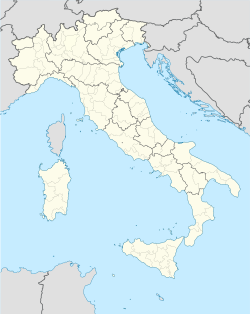Piazza Pia
| Area | 7,200 m² |
|---|---|
| Location | Rome, Italy |
| Postal code | 00193 |
| Coordinates | 41°54′09″N 12°27′52″E / 41.902398°N 12.464398°E |
| Other | |
| Known for | Near St. Peter's Basilica and Castel Sant'Angelo |
Piazza Pia is a historic square located in the Borgo district of Rome, nestled between Castel Sant'Angelo and Via della Conciliazione. Named after Pope Pius IX, the square has long played a strategic urban role and has undergone numerous transformations over the centuries.
As part of preparations for the Jubilee 2025, Piazza Pia was completely redeveloped, becoming the largest pedestrian-only urban space in the city.
History
[edit]The area now occupied by Piazza Pia has ancient origins, dating back to the Roman era. It was once near the Via Triumphalis, a major road connecting central Rome to the Vatican. One prominent structure in the vicinity was the Meta Romuli, a monumental pyramid that marked the terminus of the Via Triumphalis and possibly belonged to the Servian Wall defensive system.[1]

During the Middle Ages, the area between Castel Sant'Angelo and the Vatican was a simple open space. A covered portico road led from this location to St. Peter's Basilica, offering shelter to pilgrims. Traces of this covered route still exist today.[2]
In preparation for the Jubilee of 1450, Pope Nicholas V initiated urban renewal works to enhance the pilgrim entrance to the city. Although the project remained unfinished, it laid the groundwork for future developments.[3]
During the Jubilee of 1500, Pope Alexander VI ordered the demolition of parts of the medieval Borgo to create a new access road to St. Peter’s: the Via Alessandrina. This marked one of the most significant urban transformations of the area.[4]
By the 16th century, the area known as the *Spina di Borgo*—a narrow strip of buildings between Borgo Vecchio (Rome) and Borgo Nuovo—featured three main streets, two of which led to St. Peter’s, and one to Borgo Sant’Angelo.
In the 19th century, under the papacy of Pius IX (1846–1878), urban renewal resumed. Architect Luigi Poletti redesigned the square to improve traffic flow and better match the monumental character of nearby St. Peter’s. In 1852, Poletti introduced twin neoclassical facades at the square's entrance and designed the central Fountain of the Dolphins, inaugurated in 1861.

The fountain featured a basin supported by two dolphins and was integrated into an arched niche with Ionic columns and the papal coat of arms. It became a key landmark for pilgrims. However, during the demolition of the Spina di Borgo for the construction of Via della Conciliazione in 1936, the fountain was dismantled and later reassembled in the Vatican Gardens in 1958.[5]
By the 20th century, Piazza Pia had become a critical traffic node. A tunnel was built in 1950 beneath Lungotevere in Sassia to ease congestion, yet the square remained overwhelmed by traffic for decades, caught between its religious significance and modern urban pressures.
Redevelopment for Jubilee 2025
[edit]Ahead of the Jubilee 2025, Piazza Pia underwent a major renovation costing €85.3 million. The existing underpass was extended, and the entire surface area was pedestrianized.
The project, completed in 490 days, introduced travertine paving, benches, fountains, stairways, and tree-lined areas. It reconnected Castel Sant’Angelo and Via della Conciliazione, restoring visual harmony and creating a peaceful public space for residents and pilgrims.
Archaeological excavations uncovered a 2nd-century AD *fullonica* (ancient Roman laundry) and a garden believed to date back to Emperor Caligula. These will be relocated to the Castel Sant’Angelo gardens for public display.
Present use
[edit]Today, Piazza Pia stands as a model of sustainable urban regeneration. It serves as a cultural and religious gathering place with views of the Tiber River and St. Peter’s Basilica, hosting events and offering respite to locals and visitors alike.

See also
[edit]References
[edit]- ^ "Meta Romuli". Romano Impero.
- ^ "Piazza Pia and its transformations from the 15th century to today". Comune di Roma.
- ^ "Piazza Pia, Rome's largest urban pedestrian area". The Plan.
- ^ "The new Piazza Pia in Rome: how it has changed over time". Immobiliare.it.
- ^ "Fountain of the Dolphins". Turismo Roma.

